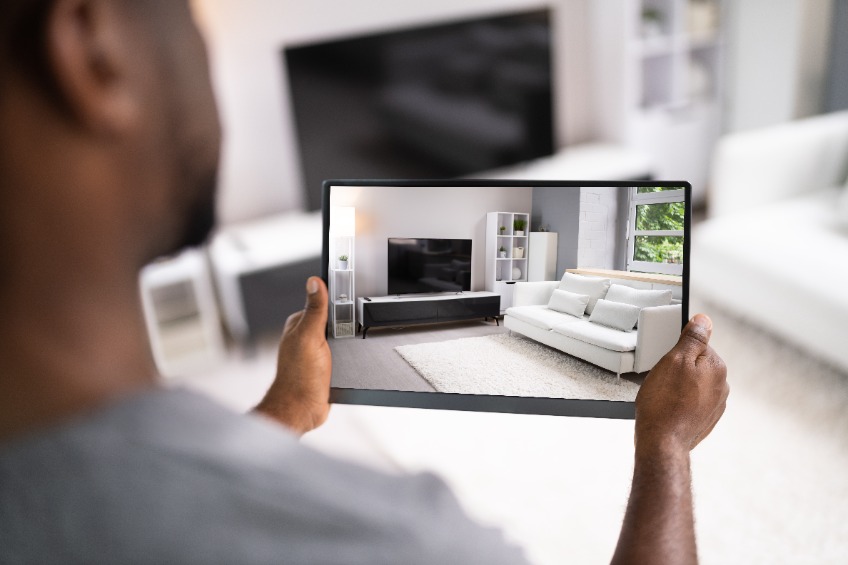
The rental property market in the UK has not only grown exponentially in size over the past years, but it has also recently become a fast-moving sector where properties are snapped up as soon as they are released onto the market. With demand for rental flats and houses outstripping supply, would-be renters are fully aware that they need to move fast to secure a property to let.
Speed is of the essence when it comes to reaching the right target audience and converting leads. Does anyone still have time to read lengthy property descriptions? The average consumer attention span is now a mere 8 seconds according to data scientists and media analysts. So, it’s worth making property descriptions concise yet still as informative as possible.
In our current digital age, visual content is steadily replacing the written word. For rental property marketers, this can only mean one thing: High-quality photos and professionally filmed video content is where we’re headed. In order to remain competitive, estate agents and letting agents must take full advantage of visual marketing opportunities on websites, property portals, and social media channels including Facebook, Instagram, YouTube, and TikTok. In this guest post, we share how to make the best video content for your rental property.
Visual Presentation Basics for Advertising Rental Properties
Photography
We all know that a picture is worth a thousand words, so there’s an opportunity right there to grab attention from the off. Stunning images that show off and advertise the merits of a property to the best effect are no longer just nice to have, they should be an essential tool in your property marketing toolbox. If you don’t have the expertise to shoot to a professional standard, use a commercial photographer with a trained eye for how to present your flat or house for rent. Make sure every room is showcased from the best angles, highlighting the best features and selling the lifestyle.
Floor Plan
Unlike online sales listings, rental property listings often don’t bother with a floor plan, but this is now a standard expectation among all property clients – buyers and renters – and across all price points too. All major property portals recommend the use of floor plans. According to Rightmove, interested parties are two-thirds more likely to make an enquiry or book a viewing if they can visualise the space with the help of layout details and measurements provided by the floor plan, while 1 in 5 say they would ignore a listing completely if no floor plan was provided. A choice of free software tools can be found online.
Video Viewings and Virtual Tours
For next-level engagement with your rental property, you should consider stepping up your visual content and using the power of the moving image. Make it super convenient for potential tenants to view your property from the comfort of their sofas by offering a virtual tour. You can do this by offering a video viewing, which involves an agent going around the property recording it with a camera, or a virtual tour which is software driven.
Video viewings are easy to record and can showcase a property in a way that photos cannot capture to give a sense of the space and the flow of the property. It is useful to record these and upload them to your rental listing for prospective tenants. Some tenants may request a live virtual tour where the letting agent or landlord uses a video sharing platform such as Whatsapp video or Zoom to give a virtual tour in real time. This allows the tenant to ask any questions too.
Virtual tours consist of a series of scans or 360 degree photos of the property which are then stitched together to create a digital version of the space that viewers can click through and navigate. Using any computer or mobile device, viewers can immerse themselves in these easy-to-use simulated showroom experiences.
Matterport are arguably the biggest name in real estate 3D but they are by no means the only software provider of virtual tours. At the click of a button, viewers are guided through a realistic simulation of the property, for a near-IRL experience without having to be physically present – handy for would-be tenants with busy lifestyles or those applying remotely. More sophisticated virtual-tour software enables agents to personalise videos with bespoke designs, 3D floorplans, and messages that interact with customers via live chat sessions.
Why Video Marketing Works So Well for Rental Properties
Whether you are a landlord or letting agent, it’s important to master the visual content marketing basics above. However, don’t rest on your laurels just yet. In today’s competitive rental property market, it’s nowhere near enough to stand out from the crowd. For that, you need to embrace the power of video marketing.
Using video effectively has a wealth of benefits that cannot be ignored. Video content improves accessibility, interactivity, and engagement with would-be tenants. It will open up your reach to wider audiences which, in turn, will raise the volume of enquiries for your rental properties.
The evidence is crystal clear. According to recent figures, real estate businesses that use video receive a staggering 403% more enquiries than those that don’t. Across all sectors, almost 90% of businesses now use video marketing and consumers spend an average of 100 minutes per day watching online video content, which is more than 80% of all consumer internet traffic. What’s more, 95% of marketing messages are retained if they are delivered via the medium of video, compared to only 15% of written content.
How to Use Video Marketing for Your Rental Property Business
Property listings with video content do better than those without. A full video tour gives the most realistic flavour of the rental property and is surely the next best thing to an actual in-person visit. Video tours proved themselves many times over in the various lockdowns when social distancing made accompanied viewings exceedingly difficult. But even as we come away from the pandemic, property videography remains a powerful marketing tool for potential tenants who are too busy or too far away to view in person.
Looking beyond the property listing, it becomes clear that video marketing has many other commercial benefits too. For letting agents, video constitutes a powerful medium to communicate with their target audience, and provide key information about their services while reinforcing and humanising their brand. Social media channels including Facebook, Instagram, YouTube, Twitter, and TikTok have become potent platforms in their own right that can be utilised to engage with potential clients and broaden the customer reach.
Here are some useful pointers to bear in mind when shooting video for your rental property:
- Keep your videos short (less than 2 minutes) so you don’t lose the viewers’ attention
- Make sure the content is relevant to your target audience and conveys a clear message
- Ensure that your videos are visually stunning and professionally filmed
- End your video with a clear call to action that you want viewers to take
- Create a video content strategy for sharing on social media
For businesses who can see the value of direct engagement and interaction with their client base, video marketing is a key growth tool that helps them stay connected with their current clientele, all the while captivating prospective tenants with convincing content showcasing the types of properties they have to offer.



